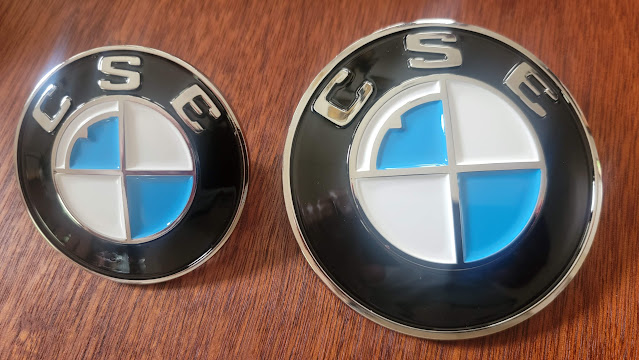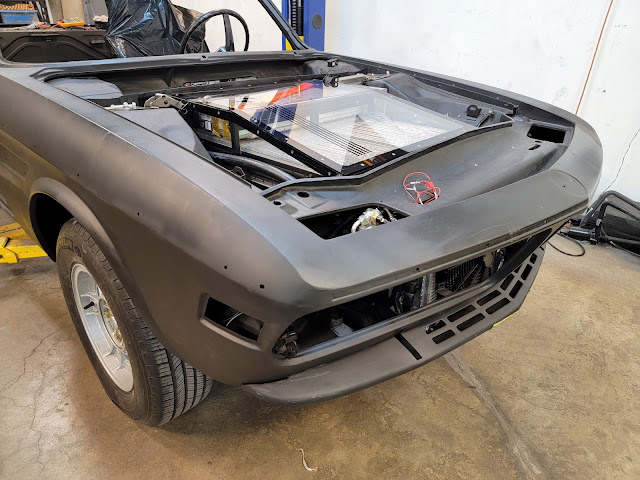So you want to build an EV...
It all sounds so easy. Just throw out that old gas engine, bolt up an electric motor, add a few batteries and you're off to the races. Or at least to the corner ice cream store in your new electric classic car. If it only it were so.

|
| A single Tesla battery cell. Slightly larger than a AA battery, based on technology from Panasonic laptop batteries. |
Sure, there are companies out there, such as EV West and Electric Classic Cars, that have been early adopters and have solved a lot of the problems, but their expertise has a price. If you just want to throw money at the problem, they're your Huckleberry. They'll get it done. But if money has meaning to you and you find satisfaction in doing it yourself then you need to look a little closer.
In the old days, engineering-minded DIYers did pretty much what I described above. They filled a car with lead-acid car batteries and a low HP electric motor bolted to the transmission and got about 30 miles of range it what was essentially a fancy golf cart.
With the advent of Lithium Ion batteries, more possibilities presented themselves. Sidebar: you do know that a Tesla battery is really just 7,000 or so Panasonic NCR18650BE (or similar) laptop battery cells all hooked together, right? I'm not kidding.

|
| A Tesla Model S Battery Module partially disassembled. Each module has 444 battery cells inside. |

|
| A complete Tesla Model S battery pack. This is 16 modules, or 7,104, cells. |
Mike Pethel was one of those engineering-type DIYers who into the game early and added two motors to his BMW 3.0 CS coupe. The downside? The trunk and rear seat were full of batteries and he didn't engineer in a battery management system so the car burnt to the ground one night while charging. So you need to be careful. Hat's off to him for doing this in an outrageous fashion, and way back in 2013, but it wasn't a "ready for prime time" conversion. It is much easier now. But it still isn't easy.
Note that, like many EV conversions, Mike's project bolted an electric motor (well, two motors in his case) to the existing transmission via a bell housing adapter plate. This makes installation much easier but it limits your packaging options for batteries (thus the back seat batteries) and means that you still have the weight and operation of the original transmission and differential. You have to operate the transmission, even though it's main purpose (multiplying torque at low RPM) is unnecessary with an electric motor. Modern Tesla's don't have transmissions. However, another advantage of this approach is that it is potentially reversible -- you could theoretically remove all the electric bits and go back to a gas engine. But why would you do that?
If you have a Volkswagen or Porsche then companies like EV West have your conversion dialed in using this method. They'll sell you a complete kit. The range will depend upon available room (a VW bus can fit a lot more batteries than a Karman Ghia) but this is a doable project.
- Motor kit: $8,000
- Batteries (12 x $800): $12,000
- BMS: $1,500
- Cables, fuses, contactor box, etc: $1,500
- Labor: Free?
Total: $23,000
That's for 71 horsepower and a range of about 100 miles.
I'm not an expert in all the available choices out there for motors and batteries. The prices will come down and the energy density will go up (more range with less space and weight) but you can see it isn't cheap.
Oh, and we forgot to mention, this is an old, light, simple VW. It doesn't have power steering, power brakes, air conditioning, or even a heater in that project. Even if your donor car has all those amenities, your EV won't. Sure, you can add them but all those items require effort to implement because in a normal car they are all run off the spinning or heat energy from a gas engine.
If you aren't scared yet, and you aren't doing a VW or Porsche, let's look at another approach...
Say, like me, you want 300 horsepower (not an outrageous number nowadays but certainly respectable, especially with the instant torque of electric) and 200 miles of range (a useable number). You still want power steering, power brakes, A/C, rear seats, and a useable trunk. And you want as close to a "true" EV experience as possible (no clutch or shifting). The Tesla approach.
Tesla combines a three-phase, four-pole AC induction electric motor with a DC to AC inverter, control electronics, and a differential, all in a single "drive unit" package that is mounted in the rear of the car between the rear wheels. In AWD models, Tesla has a second, smaller drive unit up front. The rear drive unit units come in two "sizes".

|
| The large drive unit ranges from 335 kW (449 HP) and 450 Nm (~332 ft/lb) torque to 400 kW (536 HP) and 600 Nm (~443 ft/lb) torque, depending on the model. |

|
| The base model "small" drive unit has 220 kW (294 HP) and 330 Nm (~243 ft/lb) torque. |
Obviously, these are powerful units, especially for their size. The small drive unit weighs just 194 lbs (88 kg), or 1.515 HP per lb, while the large drive unit tips the scales at 291 lbs (132 kg), as much as 1.842 HP per lb.
In most applications, it is significantly more difficult to mount one of these drive unit to a classic car but once done, there is no need for the original motor, transmission, or differential. Each drive unit has 3 large bushed mounts that can suspend the unit. Fabricate clevises for these mounting locations and build custom halfshafts and your independently rear suspended classic is Tesla powered. Adapting a Tesla drive unit to a solid axle classic car would be more difficult.

|
| A Tesla small drive unit mounted in my BMW e9 coupe |
A Tesla drive unit from a wrecked Model S can be purchased from a wrecking yard for about $3,000 but you won't know what you're getting until you hook it up and you may not know how to control it. If you buy a motor from one of the EV conversion specialists, such as 057 Technologies, it will cost $7,000-$8,000 but will come warranted and with a drive unit controller and drive-by-wire throttle pedal to control it.
- Motor: $7,000
- Batteries: $20,000
- On-board charger: $2,500
- DC/DC Converter: $1.500
- Battery Management System: $2,000
- Contactors, Fuses, Pre-Charge Controller: $1,000
- Electric A/C Compressor: $500
- Electric water pump: $200
- Electric hydraulic pump: $300
- Hydroboost or iBooster: $1,000
- Cables, busbars, etc: $500


